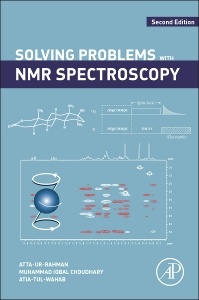Description
Solving Problems with NMR Spectroscopy (2nd Ed.)
Authors: Atta-ur-Rahman , Choudhary Muhammad Iqbal, Wahab Atia-tul-
Language: English
Subject for Solving Problems with NMR Spectroscopy:
Approximative price 71.74 €
In Print (Delivery period: 14 days).
Add to cart534 p. · 15.2x22.8 cm · Paperback
Description
/li>Contents
/li>Readership
/li>Biography
/li>Comment
/li>
It also explains new developments and concepts in NMR spectroscopy, including sensitivity problems (hardware and software solutions) and an extension of the multidimensional coverage to 3D NMR. The book also includes a series of applications showing how NMR is used in real life to solve advanced problems beyond simple small-molecule chemical analysis.
This new text enables organic chemistry students to choose the most appropriate NMR techniques to solve specific structures. The problems provided by the authors help readers understand the discussion more clearly and the solution and interpretation of spectra help readers become proficient in the application of important, modern 1D, 2D, and 3D NMR techniques to structural studies.
1. The Basics of Modern NMR Spectroscopy 2. Creating NMR Signals 3. Sensitivity Enhancement 4. Spin-Echo and Polarization Transfer 5. The Second Dimension 6. Nuclear Overhauser Effect 7. Important 2D NMR Experiments 8. Playing with Dimensions in NMR Spectroscopy 9. Some Key Developments in NMR Spectroscopy 10. Logical Approach for Solving Structural Problems
Muhammad Choudhary, PhD, is a Professor of the International Center for Chemical and Biological Sciences, (H. E. J. Research Institute of Chemistry and Dr. Panjwani Center for Molecular Medicine and Drug Research), University of Karachi, Pakistan. He is a member of the Royal Society of Chemistry, London; American Chemical Society; International Union of Pure and Applied Chemistry (IUPAC); American Society of Pharmacology; New York Academy of Sciences; Federation of Asian Chemical Societies (FACS); and he serves on the executive board of the Asian Network of Research on Anti Diabetic Plants (ANRAP). He is a recipient of the National Book Foundation's Prize for Chemistry and the Economic Cooperation Organization (ECO) Award in Education, 2006, given by the President of Azerbaijan. He has published 24 books, more than 570 papers, and 20 patents.
Atia-tul-Wahab, PhD, is Assistant Professor at the Dr. Panjwani Center for Molecular Medicine and Drug Research (International Center for Chemical and Biological Sciences), University of Karachi, Karachi, Pakistan. She is trained as a structural and synthetic organic chemist, and received additional training in structural biology in the laboratory of Nobel Laureate Prof. Dr. Kurt Wüthrich at The Scripps Research Institute. She is now establishing the first Structural Biology Laboratory of Pakistan at
- Explains and presents the most important NMR techniques used for structural determinations
- Offers a unique problem-solving approach for readers to understand how to solve structure problems
- Uses questions and problems, including discussions of their solutions and interpretations, to help readers understand the fundamentals and applications of NMR
- Avoids use of extensive mathematical formulas and clearly explains how to implement NMR structure analysis
- Foreword by Nobel Prize winner Richard R. Ernst
New to This Edition
- Key developments in the field of NMR spectroscopy since the First Edition in 1996
- New chapter on sensitivity enhancement, a key driver of development in NMR spectroscopy
- New concepts such as Pulse Field Gradients, shaped pulses, and DOSY (Diffusion Order Spectroscopy) in relevant chapters
- More emphasis on practical aspects of NMR spectroscopy, such as the use of Shigemi tubes and various types of cryogenic probes
- Over 100 new problems and questions addressing the key concepts in NMR spectroscopy
- Improved figures and diagrams
- More than 180 example problems to solve, with detailed solutions provided at the end of each chapter
These books may interest you

Organic Structures from Spectra 67.61 €



